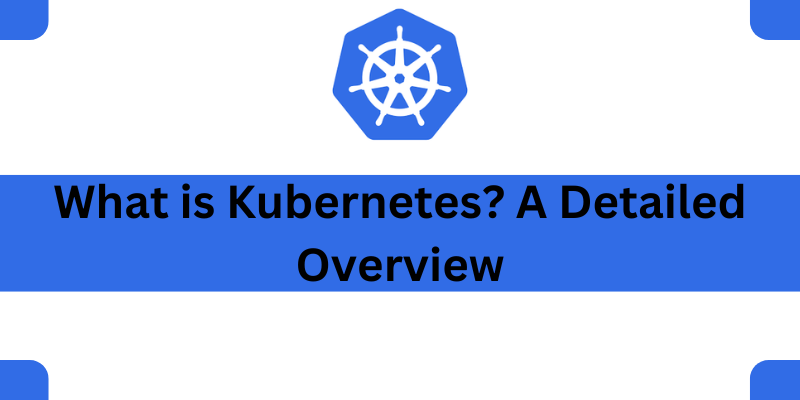What is Kubernetes? A Detailed Overview

In the realm of the internet where advancement is fueled by creativity, Kubernetes has become a game-changer for containerized application management. Imagine it like the conductor of an orchestra, balancing different instruments (or in this case, services) to produce a symphony that is effective and powerful. However, what precisely is Kubernetes and why has it emerged as the preferred platform for businesses looking to scale and achieve agility in their operations? Let us examine the specifics.
The Birth of Kubernetes
Kubernetes, also known as K8s, originated at Google, a business known for its state-of-the-art technologies. It was created to control the containers utilized by Google for its extensive services like YouTube and Gmail. When Kubernetes was made available as an open-source project in 2014, developers and businesses all across the world could use it. The goal was to provide a platform that would handle the scaling, deployment, and maintenance of containerized apps automatically, freeing up developers to concentrate on developing code rather than managing infrastructure.
Understanding Containers
Understanding containers is crucial before delving further into Kubernetes. In the context of logistics, think of containers as boxes for shipping. Software containers hold applications and their dependencies, making them portable across diverse contexts just as cardboard boxes house products and may be transferred across numerous means of transportation including ships, trucks, and trains.
Containers allow developers to package applications and all their dependencies into a single unit, ensuring consistency from development to production. However, managing multiple containers can quickly become complex, which is where Kubernetes steps in.
What Does Kubernetes Do?
Kubernetes provides a robust framework for running distributed systems resiliently. Here’s a breakdown of its core functionalities:
- Automated Deployment & Scaling: Just like a factory that ramps up production when demand increases, Kubernetes can automatically deploy and scale applications based on user demand. This elasticity ensures optimal resource utilization.
- Load Balancing: Think of a restaurant with many tables and a host. Kubernetes is the host that efficiently seats customer requests based on availability. It distributes traffic among various containers to ensure no single container is overwhelmed, enhancing performance and reliability.
- Self-Healing: In any production environment, issues will inevitably arise. Kubernetes continuously monitors the health of containers and can automatically restart or replace them if they fail. This self-healing capability ensures that applications remain available and functional.
- Service Discovery & Load Balancing: Imagine trying to find a restaurant in a big city. Kubernetes simplifies this by providing a built-in service discovery mechanism. It assigns a unique IP address to each container and enables containers to communicate with each other seamlessly.
- Automated Rollouts & Rollbacks: When a restaurant introduces a new dish, it may not always go as planned. Kubernetes allows developers to implement new features gradually, monitoring their performance. If something goes wrong, it can quickly revert to a previous version, much like a restaurant returning to a popular old dish.
The Architecture of Kubernetes
Kubernetes architecture consists of two main components: the control plane and the nodes.
- Control Plane: This is the brain of the operation. It manages the state of the cluster, making decisions on scheduling and scaling, and overseeing the overall health of the system. The control plane includes several components such as the API server, etcd (a key-value store), and the scheduler.
- Nodes: These are the workers in the Kubernetes ecosystem. Each node runs a container runtime like Docker and has the necessary tools to execute and manage containers. Nodes communicate with the control plane to receive instructions and report back on their status.
Why Choose Kubernetes?
For organizations looking to modernize their infrastructure, Kubernetes Training offers a plethora of benefits:
- Scalability: As your business grows, so can your applications. Kubernetes makes scaling easy, allowing organizations to handle increased workloads without a hitch.
- Portability: Kubernetes can run on various platforms, whether in the cloud, on-premises, or in hybrid environments, offering flexibility in deployment strategies.
- Community & Ecosystem: Being open-source, Kubernetes boasts a vast community and a rich ecosystem of tools and services that extend its capabilities. This collaborative environment fosters innovation and provides users with abundant resources.
Final Thoughts
In a nutshell, Kubernetes is not just a tool; it’s a powerful orchestration platform that empowers organizations to manage their applications efficiently and effectively. By automating deployment, scaling, and management tasks, Kubernetes allows developers to focus on what they do best: creating exceptional applications.
Whether you’re a student aspiring to enter the tech world, a decision maker contemplating modern infrastructure strategies, or a professional aiming to enhance your skill set, understanding Kubernetes is a significant step forward in today’s fast-paced digital landscape. So take the plunge into the world of Kubernetes and discover how it can transform your approach to application management. The future of technology is here, and it’s all about containers and orchestration!